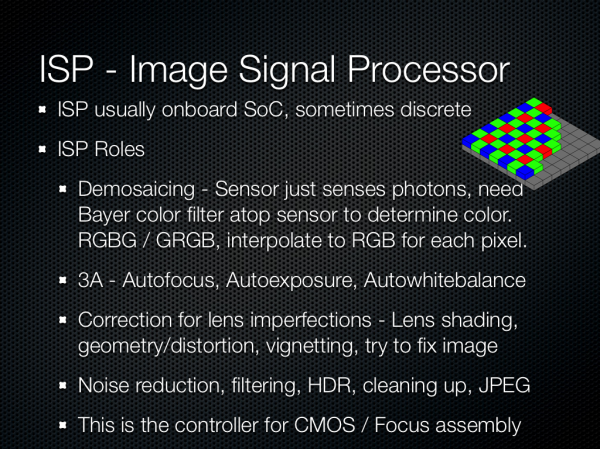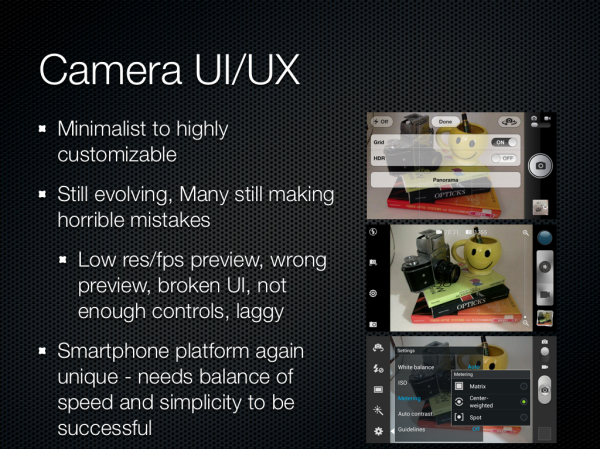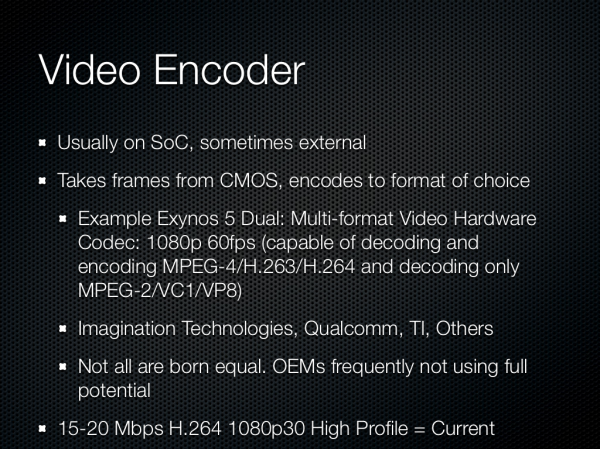Understanding Camera Optics & Smartphone Camera Trends, A Presentation by Brian Klug
by Brian Klug on February 22, 2013 5:04 PM EST- Posted in
- Smartphones
- camera
- Android
- Mobile
The Image Signal Processor (ISP)
So what purpose does ISP have? Well, pixels are sensitive to light between some set of wavelengths, essentially they’re color agnostic. The way to get a color image out is to put a filter on top, usually a bayer pattern color filter, then interpolate the color of the pixels adjacent. Your 8 MP CMOS doesn’t sense red green and blue for each pixel, it senses one color for each, then ISP guesses the color based on what’s next to it. This is called demosaicing, and it’s probably the primary job of ISP, and there are many secret sauce methods to computing this interpolated image. In addition ISP does all the other housekeeping, it controls autofocus, exposure, and white balance for the camera system. Recently correcting for lens imperfections like vignetting or color shading imparted by the imperfect lens system (which you’ll add right back in with instagram, you heathen) has been added, along with things like HDR recombining, noise reduction, other filtering, face or object detection, and conversion between color spaces. There’s variance between the features that ISP does, but this is really the controller for getting that bayer data into a workable image array.
Obviously the last part is the human interface part of the equation, which is an ongoing pain point for many OEMs. There are two divergent camps in smartphone camera UX – deliver almost no options, let the ISP and software configure everything automatically (Apple), and offer nearly every option and toggle that makes sense to the user (Samsung). Meanwhile other OEMs sit somewhere in-between (HTC, others). The ideal is an opt-in option for allowing users to have exposure control, with safe naive-user defaults. There are still many players making horrible, almost unthinkable mistakes in this area too. I wrote about how the iPhone 5 crops the preview to a 16:9 size, yet captures a 4:3 image, and later was amazed to see the AOSP camera UI on the Nexus 4 deliver an arbitrary shape (not even 16:9 or something logical) crop in the preview, and also capture a 4:3 image. Composition unsurprisingly matters when taking a photograph, and it’s mind-blowing to see established players blow off things like preview. In addition, preview framerate and resolution can be an issue on some platforms, to say nothing of outright broken or unstable user interfaces on some devices. Many OEMs have been thrust into crafting a camera UI who really have limited to no camera experience — previously it was a feature to have a camera period, much less controls. As the smartphone evolves from being a camera of convenience to the primary imaging device for most people, having robust controls for when ISP and auto exposure functionalities fail will become important. Right now camera UI and UX is rapidly changing from generation to generation, with more and more serious toggles being added. I don’t think any one player has a perfect solution yet.
For video we need to also consider the encoder. The pipeline is much the same, though the ISP will usually request a center crop or subsample from the CMOS, depending on the capabilities of the sensor. The encoder takes these images and compresses them into a format and bitrate of the OEM or user’s choice, basically H.264 at present. Not every encoder is the same, as Ganesh will tell you. There are a number of players in this market supplying IP blocks, and other players using what they have built in-house. Many OEMs make interesting choices to err on the side of not using too much storage, and don’t encode at the full capabilities of the encoder. This latest generation of phones we saw settle somewhere between 15 and 20 Mbps H.264 high profile for 1080p30 video.













60 Comments
View All Comments
gadjade - Friday, February 22, 2013 - link
How can I start reading when there is no mention of any Nokia products? HTC One should not be even included in the article because it's not even considered a breakthrough in camera phones.Krysto - Saturday, February 23, 2013 - link
Next time try reading more than the first paragraph.Diagrafeas - Saturday, February 23, 2013 - link
How many MP or to be more accurate Million Sub Pixels are these Nokia sensors because these numbers come surely after interpolation or pixel shift or something...Also do we have information about HTC One sensor?
Is it one Bayer sensor or 2-3 stacked like Foveon ones?
Krysto - Saturday, February 23, 2013 - link
While HTC definitely deserves credit for discontinuing a trend of ever more MPs, I don't think they went far enough. There's still an unclenched status quo thinking in smartphones about sensor size. Virtually all of them have a 1/3.2" sensor.No one has even thought about making that one much larger? Even after Nokia showed Pureview 808 and got a lot of praise for it? Really? What is wrong with all these companies? Do they want us to spell it out for them?
I get that clean phone design is a big factor, but you can't just keep doing things the same way everyone has always done it. And then they wonder why they can't beat Samsung. Sure Samsung has a lot of marketing power, but they also play a little less safe than everyone else. They add the S-pen to devices, even though it adds quite a bit of cost and then they need that device to compete with others, so it's a risk for them that the consumers might not want to pay extra for it - but they still do it. They also started the "phablet" trend all by themselves. And while these things don't necessarily have mass market appeal, they get a lot of publicity and quite a lot of passionate fans and customers for those devices.
So why aren't the other manufacturers experimenting in the same way not just with incrementally better cameras, but WAY better cameras, that they put in phones. I'm talking putting camera capabilities in a phone that could add $100 or even $200 to the retail price of the device. That's being BOLD in the market. That's being DIFFERENT.
So I want to see them come up with devices that have 1" large sensors of 5-8 MP, with some high quality lenses, and powerful ISP's and software behind them. Create that and you get at least 3 different types of consumers coming to buy that phone (the type of consumers that yell :SHUT UP AND TAKE MY MONEY!): professional photographers (they buy thousands of dollars worth of equipment for fun, and they need phones, too), amateur photographers (people who love taking great photos with their phones), and you'd also pretty much convert the whole (in time of course) point and shoot market to your device.
So the potential for sales is right there for reaping. And these people wouldn't get about a slight bump on the back, if they can get a phone that is 5x better than anything else on the market at the time of shipping. I want to see that kind of LEAP in smartphone cameras, not just these regular "2013 camera is slightly better than the 2012 camera", and so on.
slatanek - Saturday, February 23, 2013 - link
I think you're generally right, but these days from manufacturer's point of view it's very easy to sink the ship by being bold and not being understood well by the market/consumers. It is then very easy for their opponents to do nasty counter marketing to make things worse even further.As a photographer myself I really would like to see a no compromise smartphone camera (give glass!!! give me bigger sensor with less megapixels!!!), but I guess we're not at that point just yet. Only recently manufacturers of compact cameras started to show some interest for making cameras geared toward serious photography, so I guess it's still a few years wait to see that approach in the smartphone world.
slatanek - Saturday, February 23, 2013 - link
Besides I guess 1" sensor in a smartphone will never happen due to physical constrains - you need a lot of light gathering power to lit such a huge sensor not to mention the focal distance needs to be considerably bigger for the field of view not to be ultra wideKrysto - Saturday, February 23, 2013 - link
Pureview 808 had a 1/1.2" which is pretty close, and didn't look too bad:http://images.fonearena.com/blog/wp-content/upload...
Tarwin - Saturday, February 23, 2013 - link
That's kinda the point. It didn't look TOO BAD, which is a far cry from looking great. I also remember reading some reviews which complained about the ergonomics. Also the pure view was more of a niche experimental product.It's kind of like some article that I read years agonwhere itnsaidnthat according to research (or a survey or something) consumers, when buying a tv), were most interested in size THEN image quality and then all the other stuff. Most phone buyers are similar, they want a better camera but are not willing to give up styling for it, at least not without some re-education.
As for HTC not going far enough. I think it has more to do with the fact that they're not doing too well as is and most likely feel like they're taking enough risks at the moment.
Personally I would be willing to give up some slimness (but hopefully not styling) for a decidedly improved camera. I hope HTC does well with the One and that they are willing to experiment a bit more in future generations. But then again I am not sure yet how I feel about the loss in detail. Another site got their hands on a One and have some comparison shots between the On eand the iPhone 5
Tarwin - Saturday, February 23, 2013 - link
Oops, accidentally pressed post.Well, in the comparison shots I prefernthe images ofnthe One, but I occasionally neednthe detail procided with 8MP but then again only sometimes. When 4K TVs vecome mainstream and I also have one then I'll kost likely think it's the minimum pics should be taken at.
Krysto - Monday, February 25, 2013 - link
They can make it more stylish than that. I wouldn't mind if my phone looked a bit like a point and shoot, and didn't have a perfectly flat back surface.Again, I'm not saying these phones are for everyone. Note phones are not for everyone either. In fact I don't think I can ever see myself owning a Note phone. But yet millions of people have them, and those who do love it, and wouldn't imagine going back to a smaller phone.
That's the type of market I think such a phone can target. A niche market indeed, but a big niche nonetheless. And I would be part of that niche.